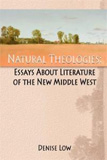Review by Mary Harwell Sayler
The Backwaters Press
3502 North 52nd Street
Omaha, Nebreska 68104-3506
ISBN: 978-1-935218-22-7
2011, pp. 185, $20.00
www.thebackwaterspress.com
Almost any innovative book that combines a discussion of literature with theology will get my attention, but when Denise Low set just such a conversation in a Midwestern locale, my interest soared even more. As a cautious kid growing up and mostly remaining in the South, I found stories of Native Americans, pioneers, frontierspeople, and cowpeople (boys or girls) intriguing because they were bold, and I was not.
As an adult accompanied by a brave spouse, I’ve since hugged the U.S. coastline, drooled over quaint little towns in rural New England, and said hi to Canada and other countries—but I’ve seldom set more than the stopover foot of an airline passenger onto the vast American plains.
Do buffalo still roam? Do people get along? Do the Indians of my childhood prefer to be called Native Americans now?
The latter question received an almost immediate answer when I saw the author’s reference to Native Americans not as Indians but Indigenous people. Good to know as I got to know the diverse voices in this “first critical study of contemporary Mid-Plains literature”—a book that includes much-admired poets and writers but also a wide range of Midwestern voices I had not previously heard.
Denise Low obviously knows each of those voices well. Not only has she taught at various universities and won prestigious awards for her own books, she’s a fifth-generation Kansan, whose roots go as deep as prairie grasslands. More importantly, perhaps, her personal lineage of European and tribal peoples have given her a uniquely blended background for intelligently discussing relevant topics—from the landscape to the Lakota to the contemporary literary achievements of native Midwesterners.
Taking cover under the book’s title, four sections come together in “A Revised Frontier Literature” (with a variety of accomplished poets and writers, including Denise Low), “Settlement. The Cities” (with Langston Hughes, David Ray, Mbembe Milton Smith, Stanley E. Banks), “Hard Land, Strong Character” (William Stafford, Robert Day, Patricia Traxler, and others), and “Natural Theologies,” which looks at “Ted Kooser’s Poetics of Devotion,” the “Poets in the Bible Belt” (Michael Poage, Jo Mcdougall, and Kathryn Kysar), and “Louise Erdrich’s Magic Spells, Prayers, and Parables.”
That fourth section drew me to the book, but touched on more than I’d imagined, such as how “American Indian religions derive belief from specific sacred sites,” or how poems by Ted Kooser “begin located in solid reality, but then surreal leaps occur.” For instance, the poem “Etude” starts with the narrator’s “watching a Great Blue Heron,” who, by the end, “would spear the whole world if he could,/ toss it and swallow it live.” As a poet who devours well-written poetry in big chunks, I totally understood the desire.
Also, in the last section, I learned that Midwestern poets who had a church upbringing seem inclined to “submerge Christian backgrounds in their writings” as they “raise theological questions and pose some answers.” For example, Michael Poage,” an ordained minister whose work I’m now eager to see, gives voice to Mary the Mother of Jesus not as a “church authority here but rather a quiet person who lives each day among ordinary details.”
In discussing other poetry by Poage, Denise Low says, “Chance meetings occur repeatedly in this poet’s works, and the moments of contact that occur without warning, like bolts of lightning from a sky god, are moments of Christian grace.”
That particular poet-pilgrim “struggles in a global landscape without sure answers,” which helped the previous sections of the book come together for me, too, as I began to see that the “new” Middle West does not present the same scene or situations Hollywood scriptwriters typically depict. As those early myths began to fall away, I saw what the author meant by migration becoming “an inner journey, reenacted through poetry, fiction, music, and film.” Although cross-country travels still take place along historical trails, they most likely occur not by horse and wagon but minivan or RV where “broken lines crisscross open grassland, often alongside contemporary throughways, [and] the past intersects the present.”
For a little Southern girl who spent her weekly allowance on Saturday matinées featuring cowboys and Indians, the book brought an abrupt change of perspective. For example, I learned that the Lakota peoples “came to represent all ‘Indian’ groups, with their eagle feather headdresses, tipis, and horses” seen on the silver screen because of a photograph someone took when at least 300 Lakota of all ages were frozen, literally, in place and figuratively in time as temperatures plunged, instantaneously preserving those killed at Wounded Knee in the last military action against Indigenous people.
The feeling of “being under siege” lingers, and yet the literature of the “New Middle West” seems more apt to adapt, innovate, and follow Low’s insightful view of Poage’s work where “Sorrow can be overcome by wonder.”
Yes, and oh, what wonders! The winters, the weather, the overpowering landscapes, the open-wide spaces, the city life, the jazz music, the pool halls, the artifacts, the mounds, the floodplains, the buffalo, the coyotes, and the voices represented in these page somehow blend, harmonize, or note the discordances. As the book sweeps across the past, present, peoples, and prairie, the eclectic voices are worth hearing, literature worth reading, and places worth envisioning even if we, like the pioneers and frontierspeople of yesteryear, only get to travel through—almost always on the way to someplace else.